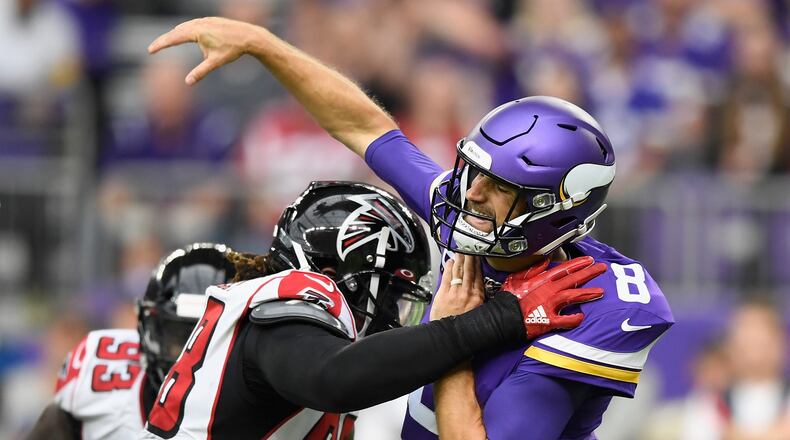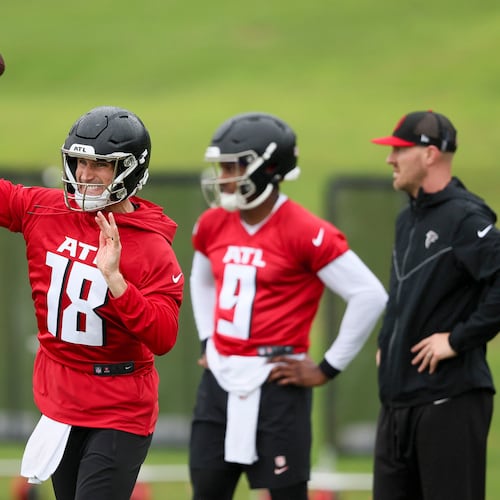The music was pounding in the players lounge, so it was hard to hear, and one had to lean in the other day to catch responses upon asking Falcons defensive linemen to grade their unit’s performance to date.
At 1-2 heading into Sunday’s game against the Titans (1-2), the Falcons need to lean in more – but not too far -- and they know it. That doesn’t mean they’re excited to say so.
They have five sacks, fewer than all but four NFL teams. On the plus side, here comes the team that has allowed more sacks than anybody. Marcus Mariota has been dropped 17 times already behind a Tennessee line missing its best blocker. Tackle Taylor Lewan is suspended.
Then, there’s this: the Vikings and Colts gouged them with the run, popping outside with shocking success to win. And, don’t you know, that’s what the Titans do most; they run the ball, chiefly with running back Derrick Henry.
So, with all that background, how would these guys grade their work as a group so far?
Defensive end Vic Beasley first ran by the question before turning it into one.
“I don’t know if I could put a grade on it,” he said in the locker room as music vibrated a room made louder still by players carrying on. “What do you give us?”
A “C” against potential.
“I think I can agree with that,” Beasley said with a slight smile of acceptance. “There’s a lot more opportunities we could’ve taken advantage of in the last three games, including myself.”
There’s a good chance that if the Falcons are going to turn the tide against AFC teams, who’ve beaten them in nine of the past 10 meetings, they’re not only going to have to slow the Titans’ run game, but get after Mariota, too.
They’d like you to know that they’re better at that than you might think.
Sure, the Falcons have more sacks than just four teams (Dolphins, Chargers and Eagles have 4; Broncos have none), but they’ve also faced fewer pass attempts through the first three games than all but five teams.
Yet in ESPN’s recently created Pass Rush Win Rate, which measures how often a team’s rush beats at least one block in less than 2.5 seconds to create pressure in a passing situation, the Falcons rank No. 5 in the NFL, at 58 percent.
Grady Jarrett (28 percent) ranks No. 1 among tackles, just ahead of the Rams’ Aaron Donald (27 percent).
The Falcons can make the argument, and they do, that they’re pressuring quarterbacks well. It’s just that they’re not getting many chances, and too many times they’re getting close without getting the ultimate result – sacks.
“I look at myself pretty rough after a game ... but it’s not like after the game I played a D-minus game, I played an A-plus game,” McKinley said. “I wouldn’t really put a grade on us. On the outside, all they look at is sacks, but the QB hits, the QB knockdowns ... people that don’t know football only see sacks.
“They don’t see that you can take over the game (with sack-less pressure). For example, the Philly game, I didn’t have no sacks but I had eight pressures and three QB hits. But people don’t care about that; they only care about the sacks. I don’t really care about the numbers as long as we’re getting in the quarterback’s face, making him make bad throws.”
The Eagles game is a good example. Atlanta won that one, and perhaps not coincidentally had 10 quarterback hits – which are indicative of getting close enough to the thrower to rush his throw – and three sacks.
Against the Vikings, it was two QB hits and one sack. Against the Colts, it was five QB hits and one sack.
Some pass-rush statistics have to do with run and down statistics.
As defensive line coach Jess Simpson said, the Falcons will better be able to get after opposing passers if they’re more often in passing situations. They need to lean in at the right times, like on first and second downs.
Plus, a couple of times, Beasley has run past would-be sacks.
“First of all, it’s just finishing. We’ve had some opps at the end of plays that we’ve made. We’ve had some opps at the end that we didn’t,” he coach explained. “I think getting in better situations, winning first and second down gets you where you want to be on third.”
Simpson looks for “third-and-we’ve got a chance to rush.”
To get there means growing more stout on first and second downs so as to create third-and-longs.
Facing 28 second-down rushing plays so far with 10 or fewer yards to go, the Falcons have surrendered 11 first-down runs. Opponents are 8-of-13 rushing for first downs on second-and-5 or less. These count as examples of bad trends setting up bad trends.
When defending third downs from 6-10 yards to go, the Falcons have held 16 of 18 times against the pass. In four against third-and-11 or more, they’re 4-0.
“There’s a lot of factors that go into that, and one of them is stopping first and second down,” defensive tackle Tyeler Davison said. “If we put ourselves in position early in the downs and early in the game to where we can go pin our ears back later on, that will give us more opportunities.
“I feel when we have opportunities, we rush well. It’s just getting to those opportunities.”
These guys believe they can get work done, and Sunday may be one of their best chances. The Titans have given up more sacks than any team (17) even though they’ve attempted the sixth-fewest passes (31.7 per game) in the NFL.
They’re ripe for sacking.
But, “First off, we’ve got to stop the run,” Beasley said. “You stop the run, then you get an opportunity to rush the passer like you want to. So, I think that’s the first key. The next step is to continue to be relentless to get to the quarterback because we all love getting sacks.”
About the Author
Keep Reading
The Latest
Featured

